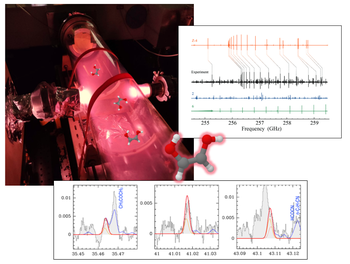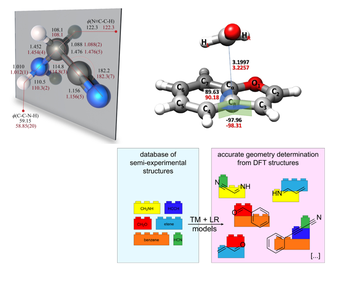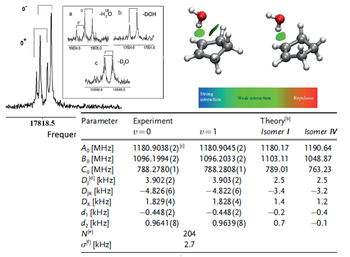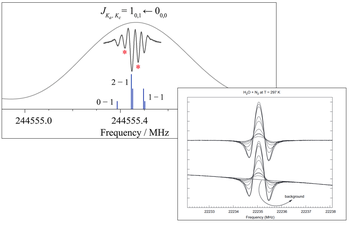Rotational Spectroscopy

Rotational spectroscopy of ions, radicals, molecules, and isotopologues of astrochemical and astrophysical interest
Rotational spectroscopy can provide fingerprints of various molecules by distinguishing them from others in the rich chemical composition of a gas phase. Based on the rotational constants and spectroscopic parameters obtained from the analysis of spectral lines measured in the laboratory, accurate predictions of rotational spectra can be obtained. These can guide species identification in complex environments such as the atmosphere or interstellar medium.
Measurement of rotational spectra for molecules of astrophysical and astrochemical interest is critical for their observation in space. In our laboratory we are measure these spectra for unstable molecules produced by pyrolysis or discharge. The measurements are then used in collaboration with astronomers (V. Rivilla, CSIC Madrid; J. Chernicharo, CISC Madrid; P. Caselli, MPE Garching, and A. Belloche, MPE Bonn) to conduct radio astronomical observations.
Some key publications are given below.

Molecular structures and force fields
Spectroscopic characterization of different isotopologues for a given molecule allows for the derivation of accurate structural parameters of a molecule. These data are combined with others of computational nature, to derive the so-called semi-experimental structure. This can be used to estimate with great accuracy the rotational constants of rare isotopologues but also to derive the geometry of more complex systems using what in our lab is called the "Lego-brick" approach.
Contextually, the analysis of vibrationally excited states is used to obtain information on the anharmonic force field for a given species.
Most recent publications on this topic:

Spectroscopic characterization of bulding-blocks of biomolecules and clusters of atmospheric, or biological, interest.
The balances between intra- and inter-molecular interactions as well as the interaction occuring with the surrounding environment (solvents, ligands, etc...) are the foundation of the study of the structure-property relationship, an important theme of the molecular approach to biology. For an accurate description of biomolecules, it is therefore essential to characterize in great detail the fundamental building-blocks, key units that, given their limited size, allow these interactions to be determined using the most accurate computational methods available. A precise description of the interactions acting in the building-blocks and their oligomers, without the perturbative intervention of the environment, is indispensable to better understand the role of the different interactions in biological activity. For this purpose, supersonic expansion rotational spectroscopy is used, which allows observation of the behavior of species in high vacuum, without interactions due to solvents or matrix effects. The use of this technique also allows the evaluation of non-bonding interactions in molecular clusters with high resolution.
Below are some key publications:

Line broadening analysis of atmospheric species and sub-Doppler spectroscopy using the Lamb-dip technique
Minor components of the atmosphere such as ozone, nitrogen and sulfur compounds, and halogenated hydrocarbons can produce important environmental effects. Monitoring of these species is done by methods based on spectroscopic techniques. For this purpose, laboratory measurement of data inherent in the line broadening due to the pressure of these species provides important information suitable for deriving quantitative data from the analysis of an atmospheric spectrum.
Lamb-dip spectroscopy improves the resolving power tenfold, allowing the identification and assignment of hyperfine structures of rotational transitions. With this technique, weak electric and magnetic interactions between rotation and nuclear spin are detectable.